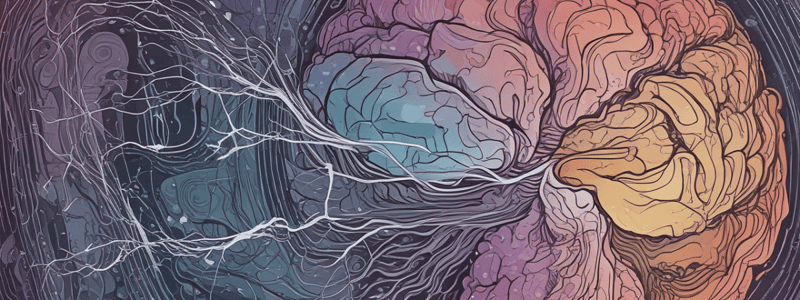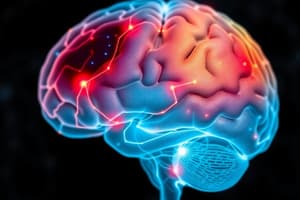Podcast
Questions and Answers
What is the primary goal of ablation studies?
What is the primary goal of ablation studies?
Which of the following methods of performing ablation is limited to removing surface-level structures?
Which of the following methods of performing ablation is limited to removing surface-level structures?
What is the mechanism by which oxidopamine lesions work?
What is the mechanism by which oxidopamine lesions work?
What is the primary advantage of neurochemical lesions over other methods of ablation?
What is the primary advantage of neurochemical lesions over other methods of ablation?
Signup and view all the answers
What is the primary characteristic of cortical cooling?
What is the primary characteristic of cortical cooling?
Signup and view all the answers
Which of the following methods of ablation involves the use of a wire to heat up and destroy tissue in a specific area?
Which of the following methods of ablation involves the use of a wire to heat up and destroy tissue in a specific area?
Signup and view all the answers
What is the effect of excitotoxic lesions on neurons with axons passing through the damaged area?
What is the effect of excitotoxic lesions on neurons with axons passing through the damaged area?
Signup and view all the answers
What is the primary advantage of using muscimol to achieve cortical cooling?
What is the primary advantage of using muscimol to achieve cortical cooling?
Signup and view all the answers
Which of the following methods of ablation involves the use of a scalpal to sever nerve fibers?
Which of the following methods of ablation involves the use of a scalpal to sever nerve fibers?
Signup and view all the answers
What is the primary characteristic of cortical cooling that distinguishes it from other methods of ablation?
What is the primary characteristic of cortical cooling that distinguishes it from other methods of ablation?
Signup and view all the answers
What is the key difference between excitotoxic lesions and oxidopamine lesions in terms of the neurons they affect?
What is the key difference between excitotoxic lesions and oxidopamine lesions in terms of the neurons they affect?
Signup and view all the answers
What is the advantage of using cryogenic blockade over surgical removal of brain tissue?
What is the advantage of using cryogenic blockade over surgical removal of brain tissue?
Signup and view all the answers
What is the primary application of cortical cooling in ablation studies?
What is the primary application of cortical cooling in ablation studies?
Signup and view all the answers
What is the key limitation of surgical removal of brain tissue using a scalpal?
What is the key limitation of surgical removal of brain tissue using a scalpal?
Signup and view all the answers
What is the effect of neurochemical lesions on the surrounding brain tissue?
What is the effect of neurochemical lesions on the surrounding brain tissue?
Signup and view all the answers
Study Notes
Ablation Studies
- Ablation studies, also known as experimental ablation, involve deliberately destroying brain tissue or making brain lesions to observe changes in an animal's behavior.
- The goal is to identify the functions controlled by the damaged regions, which can no longer be performed after the damage.
Methods of Performing Ablation
- Surgical removal of brain tissue using a scalpal or similar instrument
- Surgical aspiration, which involves sucking out brain tissue
- Limited to removing surface-level structures
- Severing nerve fibers using a scalpal, preventing signals from reaching target areas
- Radio frequency lesions, which use a wire to heat up and destroy tissue in a specific area
- Neurochemical lesions, which allow for more precision and control
- Cortical cooling, or cryogenic blockade, temporarily stops neuron function without permanent damage
Neurochemical Lesions
- Excitotoxic lesions, which use chemicals like kainic acid to bind to glutamate receptors, causing an influx of calcium that kills the neuron
- Does not affect neurons with axons passing through the area
- Oxidopamine lesions, which selectively destroy dopaminergic and noradrenergic neurons
- Works by mimicking dopamine and being taken up by reuptake channels, killing the cells
- Allows for precise control and targeting of specific neuron populations
Cortical Cooling
- Involves cooling down neurons until they stop functioning
- Can be done using a cryoloop, which circulates a chilled liquid between the skull and brain
- Temporary and reversible, allowing for the creation of temporary lesions
- Can also be achieved through neurochemical means, such as using muscimol to temporarily inhibit neurons
Ablation Studies
- Ablation studies involve deliberately destroying brain tissue or making brain lesions to observe changes in an animal's behavior, identifying the functions controlled by the damaged regions.
Methods of Performing Ablation
- Surgical removal of brain tissue is done using a scalpel or similar instrument.
- Surgical aspiration involves sucking out brain tissue, but is limited to removing surface-level structures.
- Severing nerve fibers using a scalpel prevents signals from reaching target areas.
- Radio frequency lesions use a wire to heat up and destroy tissue in a specific area.
- Neurochemical lesions allow for more precision and control.
- Cortical cooling, or cryogenic blockade, temporarily stops neuron function without permanent damage.
Neurochemical Lesions
- Excitotoxic lesions use chemicals like kainic acid to bind to glutamate receptors, causing an influx of calcium that kills the neuron.
- Excitotoxic lesions do not affect neurons with axons passing through the area.
- Oxidopamine lesions selectively destroy dopaminergic and noradrenergic neurons.
- Oxidopamine lesions work by mimicking dopamine and being taken up by reuptake channels, killing the cells.
- Oxidopamine lesions allow for precise control and targeting of specific neuron populations.
Cortical Cooling
- Cortical cooling involves cooling down neurons until they stop functioning.
- Cortical cooling can be done using a cryoloop, which circulates a chilled liquid between the skull and brain.
- Cortical cooling is temporary and reversible, allowing for the creation of temporary lesions.
- Cortical cooling can also be achieved through neurochemical means, such as using muscimol to temporarily inhibit neurons.
Ablation Studies
- Ablation studies involve deliberately destroying brain tissue or making brain lesions to observe changes in an animal's behavior, identifying the functions controlled by the damaged regions.
Methods of Performing Ablation
- Surgical removal of brain tissue is done using a scalpel or similar instrument.
- Surgical aspiration involves sucking out brain tissue, but is limited to removing surface-level structures.
- Severing nerve fibers using a scalpel prevents signals from reaching target areas.
- Radio frequency lesions use a wire to heat up and destroy tissue in a specific area.
- Neurochemical lesions allow for more precision and control.
- Cortical cooling, or cryogenic blockade, temporarily stops neuron function without permanent damage.
Neurochemical Lesions
- Excitotoxic lesions use chemicals like kainic acid to bind to glutamate receptors, causing an influx of calcium that kills the neuron.
- Excitotoxic lesions do not affect neurons with axons passing through the area.
- Oxidopamine lesions selectively destroy dopaminergic and noradrenergic neurons.
- Oxidopamine lesions work by mimicking dopamine and being taken up by reuptake channels, killing the cells.
- Oxidopamine lesions allow for precise control and targeting of specific neuron populations.
Cortical Cooling
- Cortical cooling involves cooling down neurons until they stop functioning.
- Cortical cooling can be done using a cryoloop, which circulates a chilled liquid between the skull and brain.
- Cortical cooling is temporary and reversible, allowing for the creation of temporary lesions.
- Cortical cooling can also be achieved through neurochemical means, such as using muscimol to temporarily inhibit neurons.
Ablation Studies
- Ablation studies involve deliberately destroying brain tissue or making brain lesions to observe changes in an animal's behavior, identifying the functions controlled by the damaged regions.
Methods of Performing Ablation
- Surgical removal of brain tissue is done using a scalpel or similar instrument.
- Surgical aspiration involves sucking out brain tissue, but is limited to removing surface-level structures.
- Severing nerve fibers using a scalpel prevents signals from reaching target areas.
- Radio frequency lesions use a wire to heat up and destroy tissue in a specific area.
- Neurochemical lesions allow for more precision and control.
- Cortical cooling, or cryogenic blockade, temporarily stops neuron function without permanent damage.
Neurochemical Lesions
- Excitotoxic lesions use chemicals like kainic acid to bind to glutamate receptors, causing an influx of calcium that kills the neuron.
- Excitotoxic lesions do not affect neurons with axons passing through the area.
- Oxidopamine lesions selectively destroy dopaminergic and noradrenergic neurons.
- Oxidopamine lesions work by mimicking dopamine and being taken up by reuptake channels, killing the cells.
- Oxidopamine lesions allow for precise control and targeting of specific neuron populations.
Cortical Cooling
- Cortical cooling involves cooling down neurons until they stop functioning.
- Cortical cooling can be done using a cryoloop, which circulates a chilled liquid between the skull and brain.
- Cortical cooling is temporary and reversible, allowing for the creation of temporary lesions.
- Cortical cooling can also be achieved through neurochemical means, such as using muscimol to temporarily inhibit neurons.
Studying That Suits You
Use AI to generate personalized quizzes and flashcards to suit your learning preferences.
Description
Learn about ablation studies, a technique used to identify brain functions by deliberately destroying brain tissue or making lesions to observe behavioral changes in animals.




